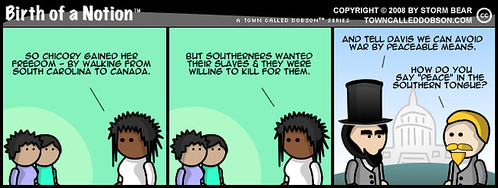 click to enlarge I am submitting Town Called Dobson to the paper for their consideration. They seem to have given great weight to receiving 200 messages considering Candorville. I am asking TCD fans to try to surpass that amount. (I get more than that many hate mails a day, surely fans can do better?) This is not a race between Darren and I, it is a hope that more progressive strips can be represented in the printed press of America. So if you read the San Francisco Chronicle or live in the Bay Area (Google Analytics tell me there are a lot of you), please send your kind comments (or naked, straining outrage) to David Wiegand at his published addresses below. If you are a subscriber, cut out your mailing label and staple it to a TCD strip and include it in your letter. candorcomment@sfchronicle.com or David Wiegand Executive Datebook Editor The San Francisco Chronicle 901 Mission St. San Francisco, CA 94103 Buzz It and Digg It Strip Essay: The main explanation for the origins of the American Civil War was slavery, especially the issue of the expansion of slavery into the territories. States' rights and the tariff became entangled in the slavery issue, and were intensified by it. Other important factors were party politics, expansionism, sectionalism, economics and modernization in the Antebellum Period. The United States was a nation divided into two distinct regions separated by the Mason-Dixon line. New England, the Northeast and the Midwest had a rapidly growing economy based on family farms, industry, mining, commerce and transportation, with a large and rapidly growing urban population and no slavery outside the border states. Its growth was fed by a high birth rate and large numbers of European immigrants, especially Irish, British, German, Polish and Scandinavian. The South was dominated by a settled plantation system based on slavery, with rapid growth taking place in the Southwest, such as Texas, based on high birth rates and low immigration from Europe. There were few cities or towns, and little manufacturing except in border areas. Slave owners controlled politics and economics. Two-thirds of the Southern whites owned no slaves and usually were engaged in subsistence agriculture, but support for slavery came from all segments of southern society. Overall, the Northern population was growing much more quickly than the Southern population, which made it increasingly difficult for the South to continue to control the national government. Southerners were worried about the relative political decline of their region because the North was growing much faster in terms of population and industrial output. In the interest of maintaining unity, politicians had mostly moderated opposition to slavery, resulting in numerous compromises such as the Missouri Compromise of 1820. After the Mexican-American War, the issue of slavery in the new territories led to the Compromise of 1850. While the compromise averted an immediate political crisis, it did not permanently resolve the issue of the Slave power (the power of slaveholders to control the national government). Amid the emergence of increasingly virulent and hostile sectional ideologies in national politics, the collapse of the old Second Party System in the 1850s hampered efforts of the politicians to reach yet one more compromise. The compromise that was reached (the Kansas-Nebraska Act) outraged too many northerners. In the 1850s, with the rise of the Republican Party, the first major party with no appeal in the South, the industrializing North and agrarian Midwest became committed to the economic ethos of free-labor industrial capitalism. Arguments that slavery was undesirable for the nation had long existed. After 1840 abolitionists denounced slavery as more than a social evil — it was a moral wrong. Many Northerners, especially leaders of the new Republican Party, considered slavery a great national evil and believed that a small number of Southern owners of large plantations controlled the national government with the goal of spreading that evil. In 1860, the election of Abraham Lincoln, who won the national election without receiving a single electoral vote from any of the Southern states, triggered the secession of the cotton states of the Deep South from the union. Birth Of A Notion Disclaimer |
Tuesday, April 22, 2008
Black History: The Causes of the Civil War
Subscribe to:
Post Comments (Atom)








0 comments:
Post a Comment